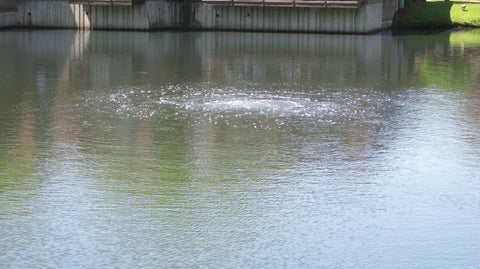
There’s no doubt that aeration is one of the best weapons in the pond managers arsenal. When done correctly, pond aeration improves water quality, combats nuisance algae, reduces organic sedimentation and protects fish from oxygen depletion. However, when misused, aeration can be ineffective, or even harmful, especially to fish.
Winter and Summer aeration are both very important and beneficial, but they are done for different purposes. In the summer, aeration is used for all the above reasons, and most involve boosting the activity of beneficial micro-organisms through increased oxygen levels. In the winter, nearly all these organisms are dormant, so the main reason to aerate is for fish survival.
Because of a thing called Thermal Stratification, in the summer the warm water is on top and the cold water is on the bottom. In the winter, it is the exact opposite, which is why ice forms on top of the pond instead of the bottom. The reason for this is because water is most dense at about 39°F. When the water cools in the fall to this temperature the surface water drops to the bottom and the bottom water rises to the top. This is natures natural aeration process, called the Fall Turnover. The same thing happens in the spring, but in reverse, when the ice melts and the surface water warms to 39°F, hence the Spring Turnover.
The period in between the turnovers is when water stratifies and causes what is known as a thermocline that separates the layers of different temperature water. This thermocline can be very sharp and pronounced. Have you ever jumped in a lake in the summer, where it was warm on top, but 8 feet down you hit bone chilling cold water? You passed through the thermocline! The problem caused by this in summer is that, in most ponds, the bottom layer runs out of oxygen. When you aerate, you bring the bottom water to the surface to be exposed to the air, and you send the surface water, which contains oxygen, to the bottom, where it is desperately needed. The introduction of oxygen to the bottom of the pond is what creates all the beneficial aspects of summer aeration.
In the winter the situation is very different. The “warm” water is on the bottom, and that is where you want to leave it. When you aerate vigorously in the winter, you send the relatively warm bottom water to the surface, and the ice-cold surface water to the bottom. This can kill fish in some situations. Also, there is not much biological activity occurring in winter, so the level of aeration required to sustain all life in the pond is much lower.
In general, you want to aerate thoroughly in the summer, with the air diffuser(s) usually in the deepest spot(s). However, in the winter you should confine aeration to the shallower areas off to the side of a pond, to prevent super-chilling the water. 50% of the maximum depth is usually what we shoot for with winter diffuser placement. With systems that have multiple diffusers, we generally shut down the deepest diffuser(s) and run the shallowest.
There are exceptions to every rule, so it is always a good idea to speak with an expert before making a big change. Also, “if it ain’t broke, don’t fix it” is a pretty good motto to live by in the pond world, so think twice before you tinker with a system that has worked well. The final word of caution is that winter aeration can and does cause locally thin ice that can be extremely hazardous to people and animals that venture onto the ice. And you are always better off losing your fish rather than a pet or person. However, by moving the aerator into shallower water and off to the side in the winter, you are reducing the area of hazardous ice, and moving it to shallower water, where someone could potentially touch bottom and get out. As a side note, many people that use their pond in winter put snow fencing up around the area of hazardous ice to prevent these situations.
Finally, when deciding which kind of aeration to use, it is important to understand that a summer aeration system can be modified to be used in winter, but your average winter aeration system cannot be used effectively in summer, except in small, shallow ponds. Because winter aeration is confined to shallower water, you can use a much lower powered compressor to generate the air. This saves you money in both initial expense and operating costs. In fact, if you shut down a summer aeration system and run a winter aerator, the winter electrical savings alone can sometimes pay for the winter aerator.
If you are interested in aerating your pond in summer and/or winter, or if you have a system that you want to modify, we would be more than happy to give you recommendations. Contact us for advice or see the following pages on our website for more information.
